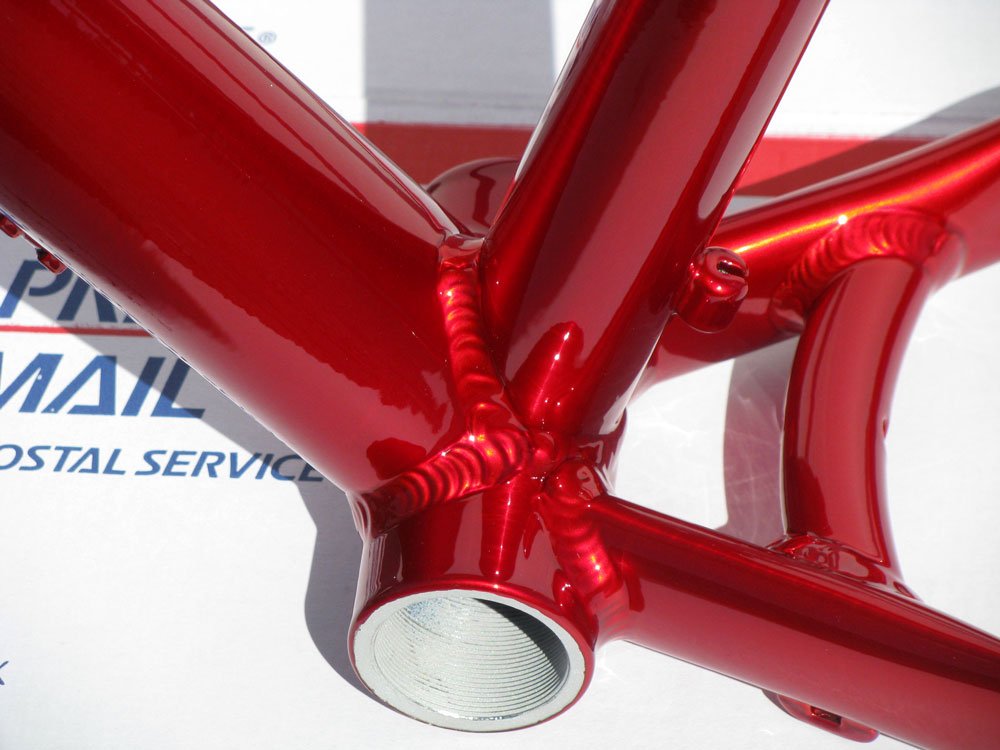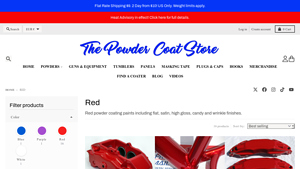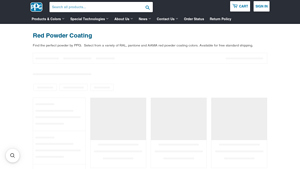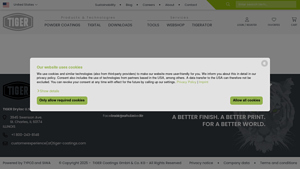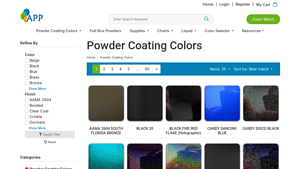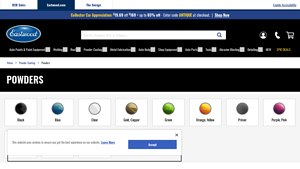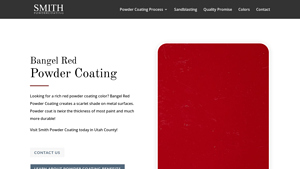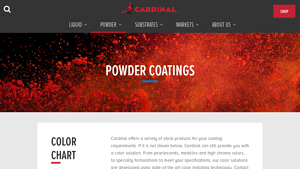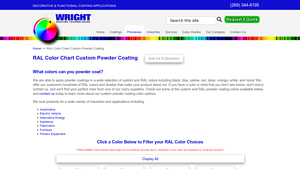Red Powder Coating Colors Guide: Type, Cost, Top List…
Introduction: Navigating the Global Market for red powder coating colors
In today’s competitive landscape, sourcing high-quality red powder coating colors can pose significant challenges for international B2B buyers. With a plethora of options available, understanding the nuances of different finishes, durability, and color matching becomes paramount. This comprehensive guide delves into the diverse range of red powder coating colors, exploring various types such as high gloss, matte, and metallic finishes, as well as their applications across multiple industries—from automotive to architectural design.
Navigating the complexities of supplier vetting is another critical aspect this guide addresses. We provide insights into assessing potential vendors, ensuring they meet your quality standards while also considering logistical factors such as shipping and customs requirements, particularly for buyers from Africa, South America, the Middle East, and Europe, including key markets like Germany and Brazil.
Furthermore, we analyze cost implications, helping you understand pricing structures and identify value-driven options without compromising on quality. By equipping you with actionable insights and strategies, this guide empowers you to make informed purchasing decisions, ultimately enhancing your product offerings and competitive edge in the market. Whether you are looking to refresh your current inventory or explore new suppliers, this resource serves as your essential roadmap in the vibrant world of red powder coating colors.
Understanding red powder coating colors Types and Variations
| Type Name | Key Distinguishing Features | Primary B2B Applications | Brief Pros & Cons for Buyers |
|---|---|---|---|
| High Gloss Red | Smooth, reflective finish that enhances color depth | Automotive, furniture, and decor | Pros: Vibrant appearance; easy to clean. Cons: Scratches may be more visible. |
| Matte Red | Non-reflective, subdued finish | Architectural elements, furniture | Pros: Modern aesthetic; hides fingerprints. Cons: May require more maintenance. |
| Candy Red | Transparent finish with a glossy base color | Custom automotive, artistic applications | Pros: Unique depth; eye-catching. Cons: More expensive; requires skilled application. |
| Wrinkle Red | Textured finish that masks imperfections | Industrial equipment, outdoor furniture | Pros: Durable; hides wear and tear. Cons: Limited color vibrancy. |
| Metallic Red | Shimmering finish with metallic flakes | Automotive, consumer electronics | Pros: Striking visual appeal; enhances product value. Cons: Higher cost; application complexity. |
What Are the Characteristics of High Gloss Red Powder Coating?
High Gloss Red powder coating is known for its smooth and reflective surface, which enhances the vibrancy of the red hue. This type is particularly favored in the automotive industry for parts like rims and body panels, where visual appeal is paramount. Buyers should consider that while high gloss finishes are visually striking and easy to clean, they may show scratches and imperfections more readily than other finishes.
How Does Matte Red Differ from Other Finishes?
Matte Red powder coating presents a non-reflective, subdued look that is increasingly popular in modern design. This finish is ideal for architectural elements and furniture, offering a contemporary aesthetic that hides fingerprints and smudges effectively. However, it may require more frequent cleaning to maintain its appearance, making it essential for buyers to weigh the aesthetic benefits against maintenance needs.
What Makes Candy Red a Unique Choice for B2B Buyers?
Candy Red powder coating features a transparent finish that allows the underlying color to shine through, creating a rich, multi-dimensional effect. This type is often used in custom automotive applications and artistic projects, where a unique and eye-catching appearance is desired. While the depth of color is a significant advantage, buyers should be aware that Candy Red can be more expensive and requires skilled application for optimal results.
Why Choose Wrinkle Red for Industrial Applications?
Wrinkle Red powder coating offers a textured finish that effectively masks imperfections, making it suitable for industrial equipment and outdoor furniture. Its durability and ability to hide wear and tear make it a practical choice for environments where aesthetics may be secondary to function. However, the limited vibrancy of color can be a drawback for buyers looking for a more visually striking option.
What Are the Advantages of Metallic Red Finishes?
Metallic Red powder coating incorporates shimmering flakes that provide a unique visual appeal, making it popular in the automotive and consumer electronics sectors. This finish not only enhances the aesthetic value of products but also conveys a sense of luxury. However, buyers should consider the higher costs and complexity of application, which may require specialized equipment and expertise.
Key Industrial Applications of red powder coating colors
| Industry/Sector | Specific Application of red powder coating colors | Value/Benefit for the Business | Key Sourcing Considerations for this Application |
|---|---|---|---|
| Automotive | Red powder coatings for vehicle parts and accessories | Enhances aesthetics and provides durable, weather-resistant finishes | Ensure compliance with automotive industry standards and regulations |
| Construction & Architecture | Architectural elements like railings, window frames, and outdoor furniture | Offers long-lasting protection against corrosion and UV damage | Look for coatings that meet specific regional environmental regulations |
| Consumer Electronics | Coating for appliances and electronic casings | Improves durability and appearance, increasing product lifespan | Source from suppliers with certifications for safety and performance |
| Agricultural Equipment | Coating for machinery and implements | Enhances resistance to harsh weather and chemical exposure | Consider coatings that offer anti-corrosive properties and are easy to apply |
| Furniture Manufacturing | Red finishes for indoor and outdoor furniture | Provides an attractive finish while ensuring durability | Evaluate the range of finishes available and customization options |
How is Red Powder Coating Used in the Automotive Industry?
In the automotive sector, red powder coatings are extensively applied to various vehicle parts, including wheels, bumpers, and trims. The vibrant red color not only enhances the aesthetic appeal but also provides a robust protective layer against environmental factors such as UV rays, moisture, and abrasions. For international buyers, especially in regions like Europe and South America, it is crucial to ensure that the coatings comply with local automotive standards and regulations to avoid penalties and ensure product longevity.
What Role Does Red Powder Coating Play in Construction and Architecture?
Red powder coatings are increasingly used in the construction industry for architectural elements such as railings, window frames, and outdoor furniture. The application of red powder coating not only adds a striking visual element but also offers superior protection against corrosion and UV damage, which is vital for outdoor installations. Buyers from Africa and the Middle East should prioritize sourcing coatings that meet specific environmental regulations to ensure compliance and durability in harsh climates.
Why is Red Powder Coating Important in Consumer Electronics?
In the consumer electronics industry, red powder coating is commonly used for appliances and electronic casings to enhance both durability and visual appeal. The powder coating process provides a tough, scratch-resistant finish that can withstand everyday wear and tear. B2B buyers in Europe and South America should consider suppliers that offer certifications for safety and performance to ensure that the coatings meet industry standards for electronics.
How Does Red Powder Coating Benefit Agricultural Equipment?
Agricultural equipment often faces harsh conditions, and red powder coatings provide an effective solution by enhancing the resistance of machinery and implements to weather and chemical exposure. This durability translates to reduced maintenance costs and extended equipment lifespan. Buyers in regions like Africa should seek coatings that are specifically formulated for agricultural use, ensuring they can withstand the demanding environments typical of farming activities.
What Advantages Does Red Powder Coating Offer in Furniture Manufacturing?
In furniture manufacturing, red powder coatings are used to create attractive finishes for both indoor and outdoor furniture. The application not only enhances the visual appeal but also ensures that the furniture is durable and weather-resistant, making it suitable for various environments. B2B buyers should evaluate the range of finishes available, as well as customization options, to meet specific design requirements and market trends in their respective regions.
3 Common User Pain Points for ‘red powder coating colors’ & Their Solutions
Scenario 1: Inconsistent Color Matching Across Batches
The Problem: One of the most pressing challenges faced by B2B buyers of red powder coating colors is the inconsistency in color matching across different production batches. This issue can arise from variations in raw materials, production processes, or even environmental factors. For businesses that rely on uniform color application for branding or aesthetic purposes, such inconsistencies can lead to customer dissatisfaction, increased rework costs, and damage to brand reputation.
The Solution: To mitigate this risk, it is essential to establish a robust quality control process when sourcing red powder coatings. Buyers should prioritize suppliers who offer comprehensive color matching services, including digital swatch samples and physical color chips. Additionally, implementing a standardized testing protocol for new batches before application can help ensure consistency. Engaging in regular communication with suppliers regarding any changes in formulation or production methods can also aid in maintaining color fidelity. For critical applications, consider investing in a color measurement tool to verify consistency in the field.
Scenario 2: Limited Availability of Desired Red Shades
The Problem: Many B2B buyers encounter difficulty in finding specific shades of red powder coating that meet their project requirements. This can be especially problematic for companies working on custom projects where a precise color is integral to the design. Limited availability can result in project delays, increased costs, and the need to compromise on quality or aesthetics.
The Solution: To address this challenge, buyers should leverage supplier partnerships to access a wider range of color options. Engage with suppliers who offer custom color formulation services or those with extensive catalogs that include specialty shades like candy red or metallic finishes. Utilizing a color matching service can allow businesses to create a bespoke color that aligns with their brand identity. Additionally, planning ahead and placing bulk orders can often secure desired shades, reducing the likelihood of stock shortages.
Scenario 3: Poor Durability and Performance of Coatings
The Problem: Another common concern among B2B buyers is the durability and performance of red powder coatings, particularly in demanding environments such as outdoor applications or industrial settings. Buyers may find that some coatings chip, fade, or corrode more quickly than anticipated, leading to higher maintenance costs and reduced product lifespan.
The Solution: To combat issues of durability, it is crucial to select powder coatings that are specifically formulated for the intended application environment. Buyers should inquire about the chemical composition and performance specifications of the coatings they are considering. Opting for high-performance coatings with features like UV resistance, anti-corrosive properties, and increased thickness can significantly enhance longevity. Additionally, implementing proper surface preparation and application techniques, such as ensuring the substrate is clean and free of contaminants, will further improve adhesion and durability. Consulting with coatings specialists can provide valuable insights into the best practices for achieving optimal performance.
Strategic Material Selection Guide for red powder coating colors
What Are the Key Materials for Red Powder Coating Colors?
In the realm of red powder coating colors, the choice of material significantly influences performance, durability, and application suitability. Here, we analyze four common materials used in conjunction with red powder coatings, focusing on their properties, advantages, disadvantages, and considerations for international B2B buyers.
1. Aluminum
Key Properties: Aluminum is lightweight yet strong, with excellent corrosion resistance and thermal conductivity. It can withstand temperatures up to 400°F (204°C) without degrading the powder coating.
Pros & Cons: The primary advantage of aluminum is its resistance to rust and corrosion, making it ideal for outdoor applications. However, it can be more expensive than steel and may require specialized handling during manufacturing due to its softer nature.
Impact on Application: Aluminum’s compatibility with various media, including water and chemicals, makes it suitable for automotive and architectural applications where aesthetic appeal and durability are paramount.
Considerations for International Buyers: Buyers should ensure compliance with international standards such as ASTM B117 for salt spray testing and consider local preferences for aluminum finishes, particularly in regions like Europe where aesthetic standards may be higher.
2. Steel
Key Properties: Steel offers high strength and durability, with a temperature rating that can exceed 600°F (316°C). Its corrosion resistance can be enhanced with appropriate primer applications.
Pros & Cons: Steel is generally more cost-effective than aluminum, making it a popular choice for various applications. However, it is prone to rust if not properly coated, which can limit its use in harsh environments.
Impact on Application: Steel’s robustness makes it suitable for industrial applications, but its susceptibility to corrosion necessitates careful selection of powder coatings that enhance durability.
Considerations for International Buyers: Compliance with standards like DIN EN ISO 12944 for corrosion protection is essential, especially for buyers in Europe. Additionally, understanding local market preferences for steel applications can guide material selection.
3. Galvanized Steel
Key Properties: Galvanized steel is coated with a layer of zinc, providing excellent corrosion resistance. It can withstand temperatures similar to regular steel, making it versatile for various applications.
Pros & Cons: The primary advantage is its enhanced durability against corrosion, making it suitable for outdoor applications. However, the surface may require special preparation before powder coating to ensure proper adhesion.
Impact on Application: Galvanized steel is often used in construction and outdoor furniture due to its resistance to weathering, but the pre-treatment process can add complexity to manufacturing.
Considerations for International Buyers: Buyers should be aware of local regulations regarding galvanized materials and the need for compliance with standards such as ASTM A123 for zinc coatings.
4. Stainless Steel
Key Properties: Stainless steel is highly resistant to corrosion and can withstand extreme temperatures (up to 1500°F or 815°C). Its non-reactive surface is ideal for various environments.
Pros & Cons: The key advantage of stainless steel is its exceptional durability and aesthetic appeal. However, it is significantly more expensive than other materials, which may limit its use in budget-sensitive projects.
Impact on Application: Its resistance to staining and corrosion makes stainless steel ideal for applications in food processing and medical equipment, where cleanliness and durability are crucial.
Considerations for International Buyers: Buyers must consider compliance with international standards such as ASTM A240 for stainless steel grades, particularly in regions with strict health regulations, such as the Middle East.
Summary Table
| Material | Typical Use Case for red powder coating colors | Key Advantage | Key Disadvantage/Limitation | Relative Cost (Low/Med/High) |
|---|---|---|---|---|
| Aluminum | Automotive and architectural applications | Excellent corrosion resistance | Higher cost compared to steel | Medium |
| Steel | Industrial machinery and structural components | Cost-effective and durable | Prone to rust without proper coating | Low |
| Galvanized Steel | Outdoor furniture and construction materials | Enhanced corrosion resistance | Requires special surface prep | Medium |
| Stainless Steel | Food processing and medical equipment | Exceptional durability and aesthetics | High cost | High |
This analysis provides a comprehensive overview of the materials commonly used for red powder coating colors, equipping international B2B buyers with the insights needed to make informed decisions based on their specific requirements and regional standards.
In-depth Look: Manufacturing Processes and Quality Assurance for red powder coating colors
What Are the Main Stages in the Manufacturing Process of Red Powder Coating Colors?
The manufacturing process of red powder coating colors involves several key stages, each critical to ensuring a high-quality end product. The primary stages include material preparation, forming, assembly, and finishing.
Material Preparation: What Raw Materials Are Used?
The process begins with the selection of raw materials, typically consisting of resins, pigments, and additives. For red powder coatings, the pigments must meet specific color and durability standards. The resins are often thermosetting polymers that provide the required hardness and resistance to environmental factors. During this stage, materials are weighed and mixed in precise proportions to achieve the desired color and performance characteristics.
How Is the Forming Process Carried Out?
Once the materials are prepared, they undergo the forming process, where the mixture is extruded into thin strands. This step is crucial as it ensures uniformity in particle size, which affects the coating’s application and finish. The extruded strands are then cooled and ground into a fine powder. The particle size distribution is carefully controlled, as it impacts the flow properties and the quality of the coating.
What Happens During the Assembly Stage?
In the assembly stage, the powder is packed into containers for shipment. It’s vital that the packaging is robust to prevent contamination and ensure that the powder remains stable during transport. Proper labeling is also essential to avoid mix-ups, especially when dealing with various shades of red.
What Finishing Techniques Are Commonly Used?
The finishing process may include additional steps such as sieving the powder to remove any oversized particles and conducting quality checks to ensure that the powder meets specifications. Certain manufacturers may also apply special treatments to enhance properties like UV resistance or to achieve specific finishes, such as glossy or matte.
How Is Quality Assurance Implemented in Powder Coating Production?
Quality assurance (QA) is integral to the powder coating manufacturing process. To ensure consistency and reliability, manufacturers typically adhere to international standards such as ISO 9001. This standard emphasizes a process-oriented approach to managing quality, focusing on continuous improvement and customer satisfaction.
What Are the Key Quality Control Checkpoints?
Quality control (QC) measures are implemented at various checkpoints throughout the manufacturing process:
- Incoming Quality Control (IQC): This stage involves testing raw materials upon arrival to ensure they meet the required specifications.
- In-Process Quality Control (IPQC): During production, samples may be taken at regular intervals to monitor for consistency in color and particle size.
- Final Quality Control (FQC): After the powder has been packaged, a final inspection is conducted. This may involve testing for properties such as flowability, color accuracy, and durability.
Which Testing Methods Are Commonly Used?
Several testing methods are employed to assess the quality of red powder coatings. These include:
- Color Matching: Using spectrophotometers to ensure that the final product matches the specified color.
- Adhesion Testing: This determines how well the coating adheres to various substrates.
- Durability Tests: These evaluate resistance to chemicals, UV light, and mechanical abrasion.
How Can B2B Buyers Verify Supplier Quality Control?
For international B2B buyers, especially those in Africa, South America, the Middle East, and Europe, verifying a supplier’s quality control measures is crucial. Here are actionable steps to ensure supplier reliability:
What Audit Processes Should Be Considered?
Conducting audits is one of the most effective ways to verify a supplier’s adherence to quality standards. B2B buyers can request to see:
- Quality Management System (QMS) Documentation: This includes policies and procedures related to quality control.
- Audit Reports: Third-party audits provide an unbiased view of a supplier’s QA processes.
How Can Buyers Request Quality Reports?
Buyers should not hesitate to ask for detailed QC reports that outline the results of various tests conducted during production. A transparent supplier will readily provide this information, which should detail:
- Test Methods Used: Including standards followed for testing.
- Results of Past Tests: This can help assess consistency over time.
What Are the Quality Control Nuances for International Buyers?
Navigating quality control can be complex for international buyers due to varying standards across regions. For example, European buyers may look for CE certifications, while those in the Middle East might prioritize compliance with local regulations. Understanding these nuances is essential for ensuring that the products meet local market requirements.
How Do Certifications Influence Quality Assurance in Powder Coating?
Certifications play a significant role in the quality assurance of red powder coatings. Many manufacturers seek certifications to demonstrate their commitment to quality and safety standards. Common certifications include:
- ISO 9001: Focuses on quality management systems.
- CE Marking: Indicates compliance with EU safety, health, and environmental requirements.
- API Standards: Relevant for coatings used in the oil and gas industry.
Conclusion: Why Is Quality Assurance Critical in the Powder Coating Industry?
In the highly competitive market for red powder coating colors, the importance of robust manufacturing processes and stringent quality assurance cannot be overstated. By understanding the intricacies of these processes and implementing effective QC measures, B2B buyers can ensure they source high-quality products that meet their specific needs. This knowledge not only aids in selecting reliable suppliers but also enhances overall business operations and customer satisfaction.
Practical Sourcing Guide: A Step-by-Step Checklist for ‘red powder coating colors’
In the competitive landscape of powder coating, sourcing the right red powder coating colors is essential for meeting both aesthetic and functional requirements. This guide provides a structured checklist for international B2B buyers looking to procure red powder coatings effectively, ensuring that they make informed decisions that align with their operational needs.
Step 1: Define Your Technical Specifications
Before you begin sourcing, clearly outline the technical requirements for the red powder coating you need. This includes understanding the desired finish (e.g., matte, gloss, satin), durability requirements, and specific application methods.
– Key Considerations:
– What are the environmental conditions the coated product will face?
– Are there specific industry standards or certifications (e.g., ASTM, ISO) that need to be met?
Step 2: Identify Your Color Requirements
Red powder coatings come in various shades, from bright cherry reds to deeper burgundy tones. Establish the exact shade or RAL color code required for your project to ensure consistency and brand alignment.
– Tips:
– Utilize color swatches and samples to visualize the finish on your intended substrate.
– Consider the impact of lighting conditions on color perception.
Step 3: Evaluate Potential Suppliers
It’s crucial to conduct thorough evaluations of potential suppliers. Look for established companies with a proven track record in providing high-quality powder coatings.
– What to Look For:
– Request company profiles, product catalogs, and case studies.
– Seek references from other businesses within your industry to gauge reliability and quality.
Step 4: Verify Supplier Certifications
Ensure that your suppliers adhere to relevant industry standards and certifications. This can serve as an assurance of quality and compliance with safety regulations.
– Considerations:
– Look for ISO certifications, environmental compliance (e.g., REACH), and safety data sheets (SDS).
– Verify if the supplier has undergone any third-party audits.
Step 5: Request Samples and Test Products
Before making a large purchase, request samples of the red powder coatings you are considering. Testing these samples will help you assess the color, texture, and adherence to substrate materials.
– Testing Focus:
– Evaluate the application process, curing times, and finish quality.
– Conduct durability tests to ensure the coating meets your specifications.
Step 6: Understand Pricing Structures and Volume Discounts
Pricing can vary significantly based on the supplier, color, and order volume. Engage in discussions regarding pricing structures and inquire about discounts for bulk orders.
– Negotiation Tips:
– Be transparent about your expected order volumes.
– Discuss potential long-term partnership benefits, which may yield better pricing.
Step 7: Establish Clear Communication Channels
Effective communication is vital throughout the sourcing process. Ensure that you have designated points of contact within the supplier organization to facilitate smooth transactions.
– Best Practices:
– Set up regular check-ins to monitor order status and address any concerns.
– Utilize digital platforms for real-time updates on order processing and logistics.
By following this structured approach, B2B buyers can navigate the complexities of sourcing red powder coatings, ensuring they select the right products to meet their operational and aesthetic needs.
Comprehensive Cost and Pricing Analysis for red powder coating colors Sourcing
What Are the Key Cost Components in Sourcing Red Powder Coating Colors?
When sourcing red powder coating colors, understanding the cost structure is crucial for B2B buyers. The main components include:
-
Materials: The primary cost driver is the quality of raw materials used in powder production. High-quality pigments and resins lead to better durability and finish, impacting the overall cost.
-
Labor: Labor costs can vary based on the region and the complexity of the coating process. Skilled technicians may command higher wages, but their expertise can lead to superior product quality.
-
Manufacturing Overhead: This encompasses all operational costs not directly tied to production, such as utilities, maintenance, and administrative expenses. Efficient manufacturing processes can help mitigate these costs.
-
Tooling: Investment in specialized equipment or molds can affect pricing. Custom tooling for specific applications may lead to higher upfront costs but can yield long-term savings through efficiency.
-
Quality Control (QC): Rigorous QC processes are essential for maintaining product standards. While they add to costs, effective QC can prevent costly defects and returns.
-
Logistics: Shipping and handling costs are significant, particularly for international buyers. Factors such as distance, shipping method, and weight can influence the total logistics cost.
-
Margin: Suppliers will include a profit margin in their pricing, which can vary based on market competition and perceived value.
How Do Price Influencers Affect the Cost of Red Powder Coating?
Several factors can influence the pricing of red powder coating colors, including:
-
Volume/MOQ: Purchasing in larger volumes often results in lower unit prices due to economies of scale. Many suppliers have minimum order quantities (MOQ) that can affect pricing flexibility.
-
Specifications and Customization: Custom formulations or specific finishes (e.g., matte, glossy, or textured) can lead to additional costs. Buyers should be clear about their requirements to avoid unexpected charges.
-
Materials: The choice of materials, such as standard versus premium-grade pigments, can significantly impact costs. Higher-quality materials generally yield better performance and longevity.
-
Quality and Certifications: Products that meet specific industry standards or certifications may carry a premium price. However, they can also provide assurance of quality and performance.
-
Supplier Factors: The reputation and reliability of suppliers can affect pricing. Established suppliers may offer better quality assurance but might charge higher prices compared to lesser-known competitors.
-
Incoterms: International buyers should be aware of Incoterms, which define the responsibilities of buyers and sellers in shipping transactions. Terms like FOB (Free on Board) or CIF (Cost, Insurance, and Freight) can affect the overall landed cost.
What Buyer Tips Can Help Ensure Cost-Efficiency in Sourcing?
To optimize sourcing strategies, consider these actionable tips:
-
Negotiation: Engage in negotiations to explore bulk discounts or favorable payment terms. Suppliers may be open to adjusting prices based on long-term relationships.
-
Total Cost of Ownership (TCO): Evaluate the total cost of ownership, including all associated costs like maintenance, replacement, and logistics, rather than just the upfront price.
-
Pricing Nuances for International Buyers: International buyers should factor in currency fluctuations, tariffs, and import duties, which can significantly impact the final cost.
-
Research and Compare: Conduct thorough market research to compare prices and quality across multiple suppliers. Leverage online platforms and trade shows to gather insights.
-
Seek Long-Term Partnerships: Building long-term relationships with suppliers can lead to better pricing, more favorable terms, and priority access to new products.
Conclusion
While sourcing red powder coating colors, understanding the complex interplay of cost components and pricing influencers is vital for making informed purchasing decisions. By applying strategic buyer tips, international B2B buyers can enhance their cost-efficiency and ensure they receive the best value for their investments. Always be mindful of indicative prices and the potential for fluctuations based on market conditions.
Alternatives Analysis: Comparing red powder coating colors With Other Solutions
Exploring Alternatives to Red Powder Coating Colors
In the quest for effective surface finishing solutions, businesses often explore a variety of options. Red powder coating colors are renowned for their durability and aesthetic appeal, but several alternative methods can also achieve similar results. This analysis compares red powder coating with liquid paints and anodizing, examining their performance, cost, implementation ease, maintenance requirements, and best use cases.
| Comparison Aspect | Red Powder Coating Colors | Liquid Paints | Anodizing |
|---|---|---|---|
| Performance | Excellent durability and finish; resistant to chipping and fading | Good, but less durable than powder coating; can chip and fade over time | Highly durable, corrosion-resistant, and aesthetically pleasing |
| Cost | Moderate initial cost; lower long-term maintenance costs | Generally lower initial cost; ongoing maintenance can add up | Higher initial cost; long-term durability can justify expense |
| Ease of Implementation | Requires specialized equipment for application and curing | Easier application with standard tools; quick drying times | Requires specific processes and equipment; can be complex |
| Maintenance | Low maintenance due to durability | Higher maintenance; periodic touch-ups needed | Low maintenance once applied; very durable |
| Best Use Case | Ideal for industrial applications, automotive parts, and outdoor furniture | Suitable for consumer goods, indoor furniture, and automotive touch-ups | Best for aluminum components in aerospace, automotive, and architectural applications |
In-Depth Look at Alternatives
Liquid Paints
Liquid paints are a widely used alternative to powder coatings. They offer a more straightforward application process, as they can be sprayed using conventional painting equipment. This method is often favored for its lower initial cost, making it accessible for small-scale operations. However, liquid paints typically do not match the durability of powder coatings, as they are more prone to chipping and fading over time. For businesses focused on indoor applications or products that require frequent touch-ups, liquid paints can be a viable choice.
Anodizing
Anodizing is an electrochemical process that thickens the natural oxide layer on metal surfaces, particularly aluminum. This alternative is known for its exceptional durability and corrosion resistance, making it ideal for applications where environmental exposure is a concern. Anodizing also offers aesthetic options, including various colors and finishes. However, the initial setup and processing costs can be higher compared to powder coating and liquid paints. Additionally, the anodizing process requires specialized equipment and a thorough understanding of the materials involved.
Making the Right Choice for Your Business Needs
When selecting a finishing solution, B2B buyers should consider several factors specific to their operational requirements. Red powder coating colors excel in durability and long-term cost-effectiveness, making them ideal for heavy-duty applications. Conversely, if initial costs and ease of application are priorities, liquid paints might be the best choice. For businesses that require superior corrosion resistance and aesthetic quality, anodizing presents an excellent option, despite its higher upfront investment. Ultimately, the right solution will depend on the intended application, budget constraints, and maintenance capabilities.
Essential Technical Properties and Trade Terminology for red powder coating colors
What Are the Key Technical Properties of Red Powder Coating Colors?
When selecting red powder coating colors for industrial applications, several technical properties are critical for ensuring quality and performance. Here are some essential specifications:
-
Material Grade
Material grade refers to the quality and composition of the powder coating material, typically polyester or epoxy. Higher-grade powders often provide better durability, resistance to UV rays, and corrosion protection. For B2B buyers, choosing the right material grade is crucial as it impacts the longevity of the coating and the overall aesthetics of the finished product. -
Gloss Level
Gloss levels can range from flat to high gloss, influencing the final appearance of the coated surface. High gloss powders tend to be more reflective and are often used for decorative applications, while flat finishes can provide a more subdued look. Understanding gloss levels helps buyers select coatings that meet both functional and aesthetic needs, particularly in industries such as automotive and architecture. -
Film Thickness
Film thickness is the measure of the powder coating layer applied to a surface, typically expressed in mils or microns. A thicker coating can enhance durability and resistance to scratches, but it may also affect the fit of assembled parts. B2B buyers should consider the required film thickness based on the environmental conditions and intended use of the coated product. -
Cure Temperature
The cure temperature is the specific temperature range at which the powder coating must be heated to achieve optimal adhesion and hardness. Typically, this ranges from 350°F to 400°F (about 175°C to 200°C). Buyers should ensure that their production processes can accommodate the necessary cure temperatures to avoid issues with coating performance. -
Chemical Resistance
This property indicates the powder coating’s ability to withstand exposure to various chemicals and solvents without degrading. High chemical resistance is essential for applications in industries such as automotive, industrial equipment, and consumer goods. B2B buyers must evaluate the chemical exposure risks to ensure their selected coatings will perform adequately over time.
Which Trade Terminology Is Important for Understanding Red Powder Coating Colors?
Understanding industry jargon is vital for effective communication and decision-making in the B2B landscape. Here are some common terms related to powder coating:
-
OEM (Original Equipment Manufacturer)
An OEM is a company that produces parts or equipment that may be marketed by another manufacturer. In the context of powder coating, OEMs often require specific color matches and performance standards for their products. B2B buyers must navigate OEM requirements to ensure compliance and satisfaction. -
MOQ (Minimum Order Quantity)
MOQ refers to the smallest quantity of a product that a supplier is willing to sell. Understanding MOQs helps buyers manage inventory levels and costs effectively. In the powder coating industry, MOQs can vary significantly based on the color and type of coating, so it’s essential for buyers to confirm these details with suppliers. -
RFQ (Request for Quotation)
An RFQ is a document used by buyers to solicit price offers from suppliers. It typically includes specifications, quantities, and delivery requirements. For B2B buyers, issuing an RFQ can streamline the procurement process for red powder coating colors, ensuring they receive competitive pricing and terms. -
Incoterms
Incoterms (International Commercial Terms) are a set of predefined rules that define the responsibilities of buyers and sellers in international transactions. They clarify aspects such as shipping costs, risk, and delivery responsibilities. Familiarity with Incoterms is crucial for B2B buyers involved in cross-border purchases of powder coatings, ensuring clarity in agreements. -
RAL Colors
RAL is a color matching system used in Europe, providing a standardized reference for colors. Many manufacturers of powder coatings offer products that match RAL specifications, ensuring consistency and quality. B2B buyers should be familiar with RAL colors to communicate effectively with suppliers and ensure that their coating choices align with design requirements.
By understanding these technical properties and industry terms, B2B buyers can make informed decisions when selecting red powder coating colors, ensuring they meet both performance and aesthetic standards for their projects.
Navigating Market Dynamics and Sourcing Trends in the red powder coating colors Sector
What Are the Current Market Trends in Red Powder Coating Colors?
The global market for red powder coating colors is witnessing significant growth, driven by increasing demand across various industries, including automotive, architecture, and consumer goods. As businesses strive for aesthetic appeal alongside durability, red powder coatings are favored for their vibrant finishes and resistance to environmental factors. Key trends include the adoption of advanced technologies in powder coating applications, such as 3D visualization tools that allow buyers to preview colors and finishes digitally before purchase. This trend is especially relevant for international B2B buyers from Africa, South America, the Middle East, and Europe, who seek to streamline their sourcing processes and ensure product quality.
Moreover, there is a rising emphasis on customization, with suppliers offering a wider range of shades, finishes, and textures to cater to specific market needs. In Europe, for instance, regulatory standards are pushing manufacturers to develop eco-friendly formulations, thus influencing sourcing decisions. In contrast, markets in Africa and South America are gradually embracing these innovations, albeit at a slower pace due to varying levels of infrastructure and investment. Understanding these regional dynamics is crucial for B2B buyers, as it shapes supplier relationships and influences cost structures.
How Does Sustainability Influence Sourcing Decisions for Red Powder Coating Colors?
Sustainability has become a cornerstone of sourcing strategies in the powder coating industry. B2B buyers are increasingly aware of the environmental impact of their purchases, prompting a shift toward suppliers who prioritize ethical sourcing practices. Red powder coatings can be produced using low-VOC (volatile organic compound) formulations, minimizing air pollution during application. Additionally, many suppliers now offer ‘green’ certifications that assure buyers of their commitment to sustainable practices.
The importance of ethical supply chains cannot be overstated, particularly for international buyers who face scrutiny from consumers and regulatory bodies alike. Companies that can demonstrate their sustainability credentials not only improve their market reputation but also gain a competitive edge. For instance, sourcing from manufacturers that utilize recycled materials in their powder coatings can significantly reduce overall environmental footprints. This trend is becoming particularly salient in Europe and North America, where consumers are increasingly demanding transparency about the products they use.
What Is the Historical Context of Red Powder Coating Colors in the B2B Sector?
The evolution of red powder coating colors can be traced back to the broader development of powder coating technologies in the mid-20th century. Initially used primarily for industrial applications due to their durability and resistance to corrosion, powder coatings have since expanded into decorative uses, including automotive and consumer goods. The introduction of advanced pigments and formulations has allowed for a richer palette, including various shades of red that cater to different aesthetic preferences.
Over the years, the industry has also seen significant technological advancements, such as electrostatic spray application methods, which enhance the efficiency and quality of powder coating processes. These innovations have enabled manufacturers to offer a wider array of finishes, from glossy to matte, and even textured coatings. Today, red powder coatings are not just functional but are also a vital part of branding and product differentiation strategies, making them an essential consideration for B2B buyers navigating this dynamic market.
Frequently Asked Questions (FAQs) for B2B Buyers of red powder coating colors
-
1. How do I choose the right red powder coating color for my project?
Selecting the appropriate red powder coating color involves considering the end application and desired aesthetic. Start by assessing the environment where the coated item will be used, as some colors may fade or chip more quickly than others. Review color samples and swatches from suppliers to ensure a perfect match with your brand or project specifications. Consider whether you need a flat, glossy, or textured finish, and request samples to test the coating’s durability and appearance before making a bulk order. -
2. What is the best red powder coating for outdoor applications?
For outdoor applications, opt for high-durability red powder coatings specifically formulated to resist UV rays, corrosion, and harsh weather conditions. Polyester-based powders are often recommended for their excellent weather resistance and color retention. Look for products that meet industry standards, such as AAMA 2604, which indicates high-performance coatings. Always request technical data sheets from suppliers to verify the coating’s suitability for outdoor use and its long-term performance under environmental stressors. -
3. What are the minimum order quantities (MOQ) for red powder coating colors?
Minimum order quantities for red powder coatings can vary significantly among suppliers, typically ranging from 1 kg to 100 kg or more. To accommodate different buyer needs, some suppliers offer flexible MOQ options for custom colors. It’s essential to clarify the MOQ during negotiations and determine if it aligns with your project requirements. Additionally, consider the potential for bulk pricing discounts if you plan to purchase larger quantities. -
4. How can I ensure the quality of red powder coatings from international suppliers?
To ensure quality, start by vetting suppliers through industry certifications such as ISO 9001, which indicates adherence to quality management standards. Request samples and conduct tests to assess color consistency, adhesion, and durability. Establish clear communication about your specifications and quality expectations. Additionally, consider third-party inspections or audits for larger orders to verify compliance with your standards before shipment. -
5. What payment terms should I expect when sourcing red powder coatings internationally?
Payment terms can vary based on the supplier’s policies, your relationship with them, and the overall order size. Common terms include upfront payment, a deposit with the balance due upon delivery, or net payment terms such as net 30 or net 60 days. Always negotiate favorable terms that mitigate risk, especially for large orders. Ensure that the payment method is secure and consider using escrow services for added protection during international transactions. -
6. How can I customize red powder coating colors to meet specific needs?
Most suppliers offer customization options for red powder coatings, allowing you to specify RAL or Pantone colors that match your branding. Discuss your requirements directly with the supplier, including finish types (e.g., matte, gloss) and any special effects (e.g., metallic or textured). Be prepared to provide color samples or references to ensure accuracy. Some suppliers may also offer digital visualization tools to preview your custom colors before production. -
7. What logistics considerations should I keep in mind when importing red powder coatings?
When importing red powder coatings, consider shipping methods, lead times, and potential customs duties. Ensure that your supplier is familiar with international shipping regulations and can provide necessary documentation, such as MSDS (Material Safety Data Sheets) and certificates of conformity. Plan for logistics by coordinating with freight forwarders who specialize in chemical products to facilitate smooth customs clearance. Additionally, factor in storage requirements upon arrival to maintain product integrity. -
8. How do I resolve issues with red powder coating quality after delivery?
If you encounter quality issues with red powder coatings post-delivery, promptly document the problems with photos and detailed descriptions. Contact your supplier immediately to report the issues and discuss potential resolutions, such as replacements or refunds. Familiarize yourself with the supplier’s return policy and warranty terms beforehand. Establishing a good relationship and clear communication with the supplier can often lead to quicker and more satisfactory resolutions.
Important Disclaimer & Terms of Use
⚠️ Important Disclaimer
The information provided in this guide, including content regarding manufacturers, technical specifications, and market analysis, is for informational and educational purposes only. It does not constitute professional procurement advice, financial advice, or legal advice.
While we have made every effort to ensure the accuracy and timeliness of the information, we are not responsible for any errors, omissions, or outdated information. Market conditions, company details, and technical standards are subject to change.
B2B buyers must conduct their own independent and thorough due diligence before making any purchasing decisions. This includes contacting suppliers directly, verifying certifications, requesting samples, and seeking professional consultation. The risk of relying on any information in this guide is borne solely by the reader.
Top 8 Red Powder Coating Colors Manufacturers & Suppliers List
1. The Powder Coat Store – Red Powder Coating Paints
Domain: thepowdercoatstore.com
Registered: 2013 (12 years)
Introduction: Red powder coating paints including flat, satin, high gloss, candy and wrinkle finishes. Products available: High Gloss Red Powder Coat Powder Paint (1 LB, From $7.99), Transparent Candy Red Powder Coating Paint (1 LB, From $11.49), Super Durable High Gloss Red Powder Coat Powder Paint (From $7.99), Flat Red Powder Coating Paint (1 LB, From $7.99), Candy Red Metallic Sparkle Powder Coating Paint (…
2. PPG – Red Powder Coating
Domain: powdercoatings.ppg.com
Registered: 1990 (35 years)
Introduction: Red Powder Coating by PPG offers a variety of RAL, Pantone, and AAMA red colors. The product is available with free standard shipping.
3. TIGER – Powder Coating Colors
Domain: tiger-coatings.com
Registered: 2000 (25 years)
Introduction: Shop Powder Coating Colors Online | Over 1,000+ Finishes, TIGER Drylac® applications, Metallics & Special Effects, TIGER Trend Colors & Finishes 2025, BattleCoats by TIGER & HyperShock, TIGER Drylac® metallics, 3D Metallics, Pearl, Antique/Vein, Dusk, Horizon, Arctic Steel, Aqua Marine Metallic, Amber, Ruby, Flame, Tangerine, Yellow, TIGITAL Inks, Tattoo, Revolutionary 3D Powder Coating Visualizat…
4. All Powder Coating Colors – Wide Variety Options
Domain: allpowderpaints.com
Registered: 2011 (14 years)
Introduction: All Powder Coating Colors include a wide variety of options such as: Antique, Patio & Furniture, Automotive (Chevy, Dodge, Ford, Harley Davidson, Kawasaki, etc.), Candy & Transparent, Clear Coats, Epoxy & Hybrid, Flat, Matte, Satin & Semi-Gloss, High Gloss & Mirror Finish, Metallics (Chrome, Reflective, Dormant, Holographic, Flip Flop, Neon, Luminous, Glow In The Dark), Primer & Filler, RAL, Panto…
5. Eastwood – Powder Coating Powders
Domain: eastwood.com
Registered: 1995 (30 years)
Introduction: Eastwood offers a variety of powder coating powders suitable for different applications. The powders come in various colors and finishes, including gloss, satin, and matte options. They are designed for durability and resistance to chipping, scratching, and fading. The product line includes specialty powders for unique effects such as metallic, textured, and candy finishes. Each powder is formulat…
6. Smith Powder Coating – Bangel Red Powder Coating
Domain: smithpowdercoating.com
Registered: 2016 (9 years)
Introduction: Bangel Red Powder Coating is a rich scarlet shade designed for metal surfaces. It is twice the thickness of most paint and offers enhanced durability. Available at Smith Powder Coating in Utah County.
7. Cardinal Paint – Powder Coating Products
Domain: cardinalpaint.com
Registered: 1996 (29 years)
Introduction: Cardinal Paint offers a variety of powder coating products including specialty finishes, superdurable options, and various color formulations such as pearlescents and metallics. Key product categories include:
– Superdurable Coatings
– Epoxy Coatings
– TGIC Polyester
– Polyurethane
– Specialty Finishes
– Conductive Coatings
– Adhesion Promoters
– Metal Conditioners
The color chart featur…
8. Wright Coating – RAL Powder Coat Color Chart
Domain: wrightcoating.com
Registered: 1998 (27 years)
Introduction: RAL Powder Coat Color Chart – Custom Powder Colors available in a wide selection including black, blue, yellow, red, silver, orange, white, and more. Hundreds of RAL colors and shades offered. Custom color options available upon request. Industries served include Automotive, Electric Vehicle, Alternative Energy, Appliance Fabrication, Furniture, and Fitness Equipment.
Strategic Sourcing Conclusion and Outlook for red powder coating colors
In summary, the strategic sourcing of red powder coating colors presents significant opportunities for international B2B buyers. By understanding the diverse range of finishes—from high gloss to textured options—companies can tailor their offerings to meet the specific aesthetic and functional needs of their markets. The durability and versatility of powder coatings make them an ideal choice for various applications across industries, including automotive, architecture, and consumer goods.
Investing in strategic sourcing not only enhances product quality but also fosters long-term supplier relationships, ensuring a reliable supply chain. Buyers are encouraged to leverage advanced tools and resources, such as color visualization technologies, to make informed decisions that align with market trends and consumer preferences.
As the global demand for high-quality powder coatings continues to rise, particularly in emerging markets across Africa, South America, and the Middle East, now is the time to capitalize on these trends. Engage with reputable suppliers, explore innovative color options, and ensure your product lines stand out in a competitive landscape. By prioritizing strategic sourcing, you can position your business for sustained growth and success in the dynamic powder coating market.

